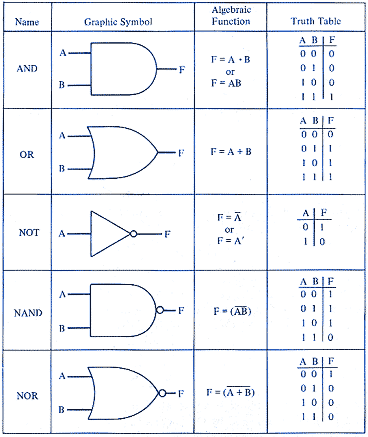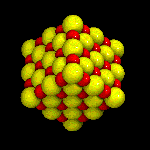 With a lot of things I find my understanding coming from the tiny detail end, and the big picture end, and failing to entirely meet in the middle. I saw this when I was studying computer science. I can understand how AND, OR, and NAND gates work, and have even designed and implemented a circuit that can add a pair of binary numbers of four digits (using eight switches for input and five LEDs for the output) out of these basic components. And I've learned about assembly language, bus addressing, etc. But I can't bridge the gap: I can't quite say I understand how a bunch of combinations of logic gates could become even a simple 6502 CPU. I have every confidence it can, but I couldn't do it.
With a lot of things I find my understanding coming from the tiny detail end, and the big picture end, and failing to entirely meet in the middle. I saw this when I was studying computer science. I can understand how AND, OR, and NAND gates work, and have even designed and implemented a circuit that can add a pair of binary numbers of four digits (using eight switches for input and five LEDs for the output) out of these basic components. And I've learned about assembly language, bus addressing, etc. But I can't bridge the gap: I can't quite say I understand how a bunch of combinations of logic gates could become even a simple 6502 CPU. I have every confidence it can, but I couldn't do it.By contrast, I feel I can bridge the gap between assembly language and high-level programming languages, because of more familiarity. I've actually implemented very simple compilers and interpreters, and I have worked in very low level languages, and seen how to use them to build higher-level languages. So I've taken every step of complexity enough to feel I understand them, I don't just have to assume them. There was a time when I could have written a C compiler in assembly if I had to -- it would have been a gargantuan task, and futile, but knowing that I could was enough.
No doubt if I had spent a couple of years building more complex logic circuits I would have gotten to where I felt that I could, if pressed, have built a very simple CPU, and that, too, would have been enough. But I only did enough of the low level stuff to be exposed to it and then I moved on. My focus was higher-level stuff.
In a very similar way, I feel like I understand a lot about evolution (at least for a well-read layman with a scientific mindset) and how you can get from a very simple creature like a bacterium, and build up from there to very complex creatures like grasshoppers, pigeons, and Eddie Izzard. And from my studies of biochemistry I can understand how molecules form and interact, enough that I feel I have a general idea of how DNA could replicate, and could probably follow a more detailed explanation if one were presented. But there are several gaps that I couldn't bridge myself, and I just have to assume them.
The biggest one is the phenotypic expression: I understand the principle of how genes affect embryonic development by synthesizing different combinations of enzymes and other compounds, but it's dizzying to contemplate how a slightly different sequence of genetic characters on a gene in one spot should cause eyes to be blue instead of brown, amidst the flurry of millions of genes in trillions of cells interacting in quintillions of ways. I just have to believe that there's a path that not only explains how changing that A to a T would have made the eyes brown, but that ensures that all the other molecules involved in making an iris would do their parts, and all the DNA bits that control all the parts of the process would all affect the right parts. How do the molecules know which bit of my chromosome to read when it's time to figure out what pigments to put into my iris? I know that that's the wrong question, but I can't say I grasp the right question in more than blurry terms.
Another one is biogenesis. Evolution is inevitable once you have replicators which can change sometimes, and which can influence their own ability to replicate. But I've always had to take for granted that it's possible to have such replicators form from ordinary randomly-occuring molecules, and supplement this idea with the usual pastiche of facts about spontaneous generation of amino acids in interstellar gas clouds. Dawkins provides a lovely example of one possible way to do that, derived from the works of Graham Cairns-Smith, which really helped me bridge this gap. It's possible that this idea is how it happened, or related to how it happened, but it's not necessary. It's just enough that it shows one way it could have happened, to make me understand how it could in a way that doesn't require me to just accept it.
 The example given is crystal formation. Consider crystals, which obviously occur in nature. A crystal is a mineral where the atoms form into neat, orderly patterns, and the reason they do this is very simple, easily understood chemistry. The atoms fall into one spot and not another because that's where the forces balance. That's true of all molecules. Crystals are those molecules where the pattern of where atoms land is repeating, like a tile pattern on a bathroom floor. Table salt is essentially a lattice of right angles with alternating sodium and chlorine atoms at each point, so as another sodium atom wanders by, it will always fall into place at the next point in that three-dimensional grid, thus extending the repeating pattern.
The example given is crystal formation. Consider crystals, which obviously occur in nature. A crystal is a mineral where the atoms form into neat, orderly patterns, and the reason they do this is very simple, easily understood chemistry. The atoms fall into one spot and not another because that's where the forces balance. That's true of all molecules. Crystals are those molecules where the pattern of where atoms land is repeating, like a tile pattern on a bathroom floor. Table salt is essentially a lattice of right angles with alternating sodium and chlorine atoms at each point, so as another sodium atom wanders by, it will always fall into place at the next point in that three-dimensional grid, thus extending the repeating pattern.In essence, a bit of a crystal is a replicator because it makes more bits of crystal of the same shape, in the process of it growing. In fact, you can make self-replicating molecules in your kitchen, just by making a super-saturated mixture (heat up some water and add lots and lots of salt, then let it cool while making sure no dust or bubbles get into it) and then adding a tiny grain of salt, which will soon "seed" lots more of the same crystal. It's not much of a stumbling block that the crystal's "growth" doesn't feel like "reproduction" since it's all one crystal: no one thinks algae aren't reproducing when they split and then stick together, and besides, crystals can and do break.
Crystals don't always form perfectly, though. So there is a chance for crystals to "mutate" when an imperfection forms on one side of the growth, and then encourages more growth following the new pattern. And it's entirely possible that such a mutation could have better or worse ability at growing, by being able to attract the necessary atoms and molecules in the nearby area better or worse.
Crystals forming in a water flow (which is where they usually form) might even block up the water, causing the flow to speed up or slow down, allowing more accumulation of sediment of the right type. This is probably happening underground in your backyard. And naturally, any crystal that's better at replicating is likely to start appearing more than others.
Dawkins and Cairns-Smith aren't suggesting that we're made of crystals, or that there's a secret world of crystal lifeforms underground. There's a suggestion that crystals could have formed the environment in which more sophisticated replicators could come to be, so crystal replicators might have been a step towards DNA and cockroaches and Eddie Izzard, but that's not even necessary. It's enough that now I can see how atomic forces I understand can make replicators that can mutate and select. In fact, I already knew about it, it just hadn't occurred to me that crystal growth is replication. So now I feel better about the idea of amino acids (which I know spontaneously generate very easily, and which I know are far more complex than crystal lattices) might do the same thing. If I had the time and motivation I could probably look at amino acids and figure them out and then understand how they could replicate and mutate. It'd be as difficult as writing that C compiler in assembly, and no point since someone else already did, but I'm glad to know that now I understand enough (I think) that I could.

 RealTime and RTC
RealTime and RTC Prism
Prism Uncreated
Uncreated Bloodweavers
Bloodweavers Foulspawner's Legacy
Foulspawner's Legacy Lusternia
Lusternia
No comments:
Post a Comment